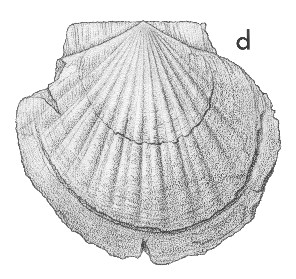
Revised descriptions of New Zealand Cenozoic Mollusca from Beu and Maxwell (1990)

 | Revised descriptions of New Zealand Cenozoic Mollusca from Beu and Maxwell (1990) | 
|
  (Pl. 5d): GS9886, J40/f8823, abandoned railway cutting, Waihao Downs, Bortonian (GNS) |
Beu & Maxwell (1990): Chapter 7; p. 100; pl. 5 d.
Synonymy: Pecten (Pseudamusium) [sic] waihaoensis Suter 1917, p. 69; Lentipecten (Duplipecten) waihaoensis
Type species of Duplipecten Marwick, 1928
Classification: Pectinidae
Description: Size moderate for family (height 50-60 mm), right valve more inflated than left; anterior and posterior gapes well developed. Ears prominent, those on left valve having colinear dorsal margins, and separated from disc by shallow grooves; those on right valve with divergent dorsal margins (finely serrate on well preserved shells) and separated from disc by broad channels which dip below dorsal margins of disc distally. Byssal notch well developed; no ctenolium. Sculpture on right valve of fine growth lines and faint radial striae; left valve with growth lines and weak radial striae in some shells, others with 12-14 broad, low, flattened costae becoming obsolete distally; interspaces as broad as costae, some with a weak radial cord appearing during growth.
Comparison: Pectens conforming to the above diagnosis (i.e. including individuals with well developed radial costae in the left valve) are present in the middle part of the Waihao Greensand in the Waihao Downs section. Higher in the section, particularly in a pecten-rich bed near the top of the Bortonian, occur pectens identical in most respects to Duplitecten waihaoensis but having the left valve devoid of radial sculpture other than weak striae. These are assigned to D. parki, which is recorded from several Bortonian and Kaiatan localities in North Otago (type locality, Hampden Beach), South Canterbury, Westland and Chatham Island. Although originally assigned to Lentipecten (sensu stricto), D. parki is very similar to D. waihaoensis and the two species probably have an ancestor-descendant relationship, with D. parki replacing the latter species in the late Bortonian. This relationship was discussed further by Maxwell (1992, pp. 64-65). Duplipecten was originally classed as a subgenus of Lentipecten, but the type species differ in a number of important shell characters that indicate they are not closely related. Loss of radial sculpture has occurred in many groups of pectens and is not in itself a reliable guide to phyletic relationships in the family, and Beu & Darragh (2001, p. 122) pointed out that similar, superficially smooth "saucer scallops" have evolved at least 5 times in New Zealand and southern Australia during the warmer Eocene-Miocene period. Waller (2006, pp. 13, 14) included all these smooth scallops in his new Tribe Adamussiini, in subfamily Palliolinae. However, he pointed out also (Waller 2006, p. 12) that superficially smooth, early Cenozoic, similar-looking scallops in the Northern Hemisphere such as Pseudentolium and Korobkovia evolved independently. He assigned them to the separate, new Tribe Pseudentoliini.
Distribution: Bortonian, Waihao Greensand, South Branch, Waihao River near Waihao Downs (type) (locally common).
Cite this publication as: "A.G. Beu and J.I. Raine (2009). Revised
descriptions of New Zealand Cenozoic Mollusca from Beu and Maxwell (1990). GNS
Science miscellaneous series no. 27."
© GNS Science, 2009
ISBN
978-0-478-19705-1
ISSN 1177-2441
(Included with a PDF facsimile file
copy of New Zealand Geological Survey Paleontological Bulletin 58 in CD version
from: Publications Officer, GNS Science, P.O. Box 30368 Lower Hutt, New
Zealand)